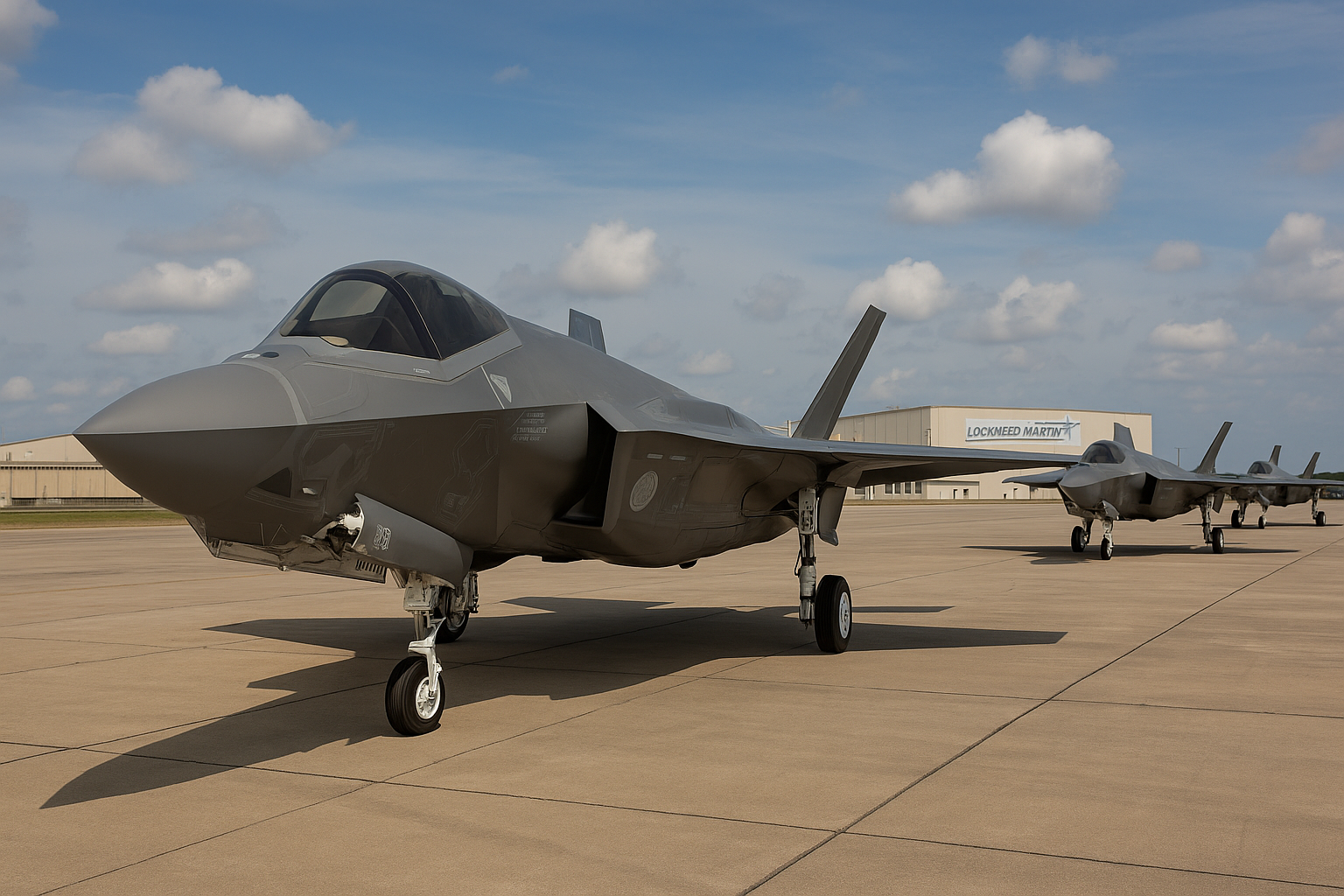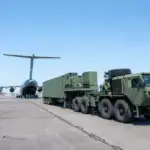The Pentagon owns many early-lot F-35s that cannot meet full combat standards. Commanders now stand at a fork in the road: pour money into deep retrofits or buy fresh jets straight off Lockheed Martin’s moving line in Fort Worth. Vice Adm. Mat Winter, then head of the Joint Program Office, told reporters on Sept 18 that annual production would climb from forty-six aircraft in 2016 to about one hundred thirty in 2018 and rise again afterward. At the same time, he warned that the oldest airframes needed “one hundred fifty to one hundred sixty modifications” before they could fly real combat sorties. That number alarmed budget staff because each alteration grounded a jet for months and soaked up scarce depot slots.
F-35 Upgrade Costs and Depot Bottlenecks Delay Combat Readiness
Early production overlapped with flight testing, a decision called concurrency. Concurrency let the program claim fast fielding but left the fleet scattered across software, hardware, and structural baselines — a fragmentation that later drove the Air Force to propose a radical F-35 upgrade to unify capabilities. Upgrading the first Low-Rate Initial Production aircraft can now cost close to one hundred million dollars per tail after workers strip away panels, reinforce bulkheads, replace mission computers, and rewire boxes. Every hour spent on those tasks also denies mechanics to newer lots, and the JPO cannot solve the crunch by flipping a switch.
Depot capacity remains thin. Ogden Air Logistics Complex accepts only eight F-35s at a time for heavy work, and each job averages seven months. If every slot stayed full, more than two hundred early jets would wait in line by 2022. Managers tested a hybrid fix that combines scheduled maintenance with retrofit kits and uses partner depots in Italy and Australia for lighter tasks, yet even that approach strains manpower.
F-35 Program Cost with Production and Modernization Pressures
Cost pressures push the debate toward hard trade-offs. Unit price for a Lot 11 F-35A sat near ninety-four million dollars fly-away, and learning curves showed more room to fall. That figure compares favorably with the price to modernize a 2012-vintage tail that still carries a shorter fatigue life and dated wiring looms. Fiscal hawks inside Congress argued that “chasing sunk costs” made no sense when new aircraft promised longer service and lower sustainment.
Service staffs saw the math in different light. The U.S. Air Force, which owns the largest share of F-35s, calculated a four-billion-dollar bill just to raise its forty LRIP 2–4 tails to combat spec. Some planners floated the idea of shifting them to training duty and ordering extra Lot 15 and above jets for front-line squadrons. The Marine Corps faced its own challenge after declaring Initial Operational Capability in 2015 with Block 2B B-models that could not fire AIM-9X or integrate StormBreaker. The Corps looked at a “strip-and-rebuild” plan at Cherry Point that would trade flight hours now for full lethality later. Navy air wings wanted Block 3F C-models on deck before the first carrier cruise in 2021, but carrier depots already juggled F-18 workloads and could not afford long pull-outs.
Weapon employment gaps underscored the stakes. Forward-based F-35Bs in Japan and F-35As in Europe could handle air-defense patrols and basic strike, yet advanced weapons such as the Small Diameter Bomb II, Maritime JDAM, and AIM-9X needed Block 3F. Pacific commanders worried that deterrence flights would lose credibility if aircrews could not load the same ordnance promised in war plans.
Partners felt knock-on effects as well. Italy, Australia, Norway, and the Netherlands all owned early blocks and depended on U.S. software schedules to unlock new features. Any slip in American depots forced allied fleets to delay their own upgrades, disrupted multinational exercises, and complicated spare-parts pooling.
Lawmakers tried to juggle those realities. The Fiscal Year 2018 request funneled 1.3 billion dollars into modifications, but staff projections put the total above eight billion through FY 2023 once the program pivoted to Block 4 Continuous Capability Development and Delivery. That next block required the newer TR2 mission computers, so any jet stuck on the original TR1 hardware faced a cliff. Some officials spoke aloud about retiring the first one hundred eight airframes once they finished trainer duty, then harvesting their F135 engines and spare parts for later lots. Bases that hosted those tails pushed back hard, arguing that early retirement threatened local jobs and pilot pipelines.
F-35 Production Impacted by Retrofit Delays and Supplier Constraints
The industrial base added its own leverage. Lockheed Martin and key suppliers warned that slowing production to shift money into retrofits could break supply chains and raise unit cost. They framed the choice as “modernize while we build,” claiming that retrofit work kept depots warm and software teams sharp. Detractors replied that the plan masked true program cost and delayed a clean fleet.
By autumn 2017, Pentagon leaders had no clear path. They could not fund full-rate buys and full-scale retrofits under current budget caps, yet either line alone left readiness gaps. In practice, they adopted a year-to-year balance: moderate production buys, steady but limited modification funding, and constant promises that next year’s software drop would solve most issues.
Here are the heaviest retrofit tasks that lay ahead in 2017:
- Swap early TR1 mission computers for TR2 sets that host Block 3F code.
- Reinforce bulkheads that cracked during durability testing.
- Install redesigned fuel-dump pipes and lightning-protection plates around the OBIGGS system.
- Rewire obsolete electronic-warfare racks so they accept new AESA modules and cooling lines.
Service staffs also charted their own risk paths:
- Air Force leaders weighed selling or mothballing twenty-plus LRIP jets once training demand fell, using the saved money to buy fresh Lot 15 airframes.
- The Marine Corps plotted short depot sprints that would lift its oldest B-models straight to Block 4 when parts became available, betting that acceptable readiness levels would return by 2023.
- The Navy argued that only new C-models could enter the carrier air wing on time because its depots had no spare days for deep retrofits during an eighteen-month work-up cycle.
Even with those internal strategies, the overarching question in 2017 sounded simple yet carried sweeping effects: should the United States pay the retrofit bill or widen the production ramp and let the oldest tails fade away? No final answer emerged before the fiscal clock forced another annual compromise.
Block 4 Delays and TR3 Bottlenecks Hamper F-35 Upgrade Plans – Update March 2025
The program now fields nine hundred seventy-five F-35s, but nearly four hundred sit idle because they lack Technology Refresh 3 hardware that unlocks Block 4 software. Lockheed Martin stopped deliveries in 2023 while engineers chased processor-cooling faults; production resumed in July 2024, yet only forty-one jets reached units before year-end. Current Lots 15 and 16 leave the factory with placeholder code that limits weapons employment until the full TR3 stack clears operational test later this year.
Depot Capacity Crisis Threatens Timelines for F-35 Modernization
Commanders once spoke of dozens of tails awaiting kits; they now see entire wings on jacks. Clearing every pre-Lot 15 aircraft to TR3 will push into 2029 unless Congress grants more hangars and hires thousands of additional artisans. The Fiscal Year 2026 budget seeks 1.9 billion dollars to expand Ogden and Fleet Readiness Center East and to rent commercial bays for airframe strip-downs. Debates in the House Armed Services Committee remain tense because the same bill trims procurement dollars. At the same time, persistent F-135 engine problems add another layer of risk to meeting modernization schedules.
Cost growth outpaced even pessimistic forecasts. A Government Accountability Office report issued last month pegs Block 4 development and retrofit at 16.5 billion dollars, up a full billion since 2023. Program lifetime price tag tops 2 trillion dollars when sustainment projections received a planned twenty-five-year extension. Senators call the figure “the largest weapon-system total in Pentagon history.”
Congress cut the FY 2025 buy from sixty-eight to fifty-eight F-35s and fenced money for ten more until TR3 proves stable during flight test at Edwards Air Force Base. The average unit cost for an F-35A settled near 82.5 million dollars, yet lawmakers judged schedule risk more dangerous than price.
TR3 Delays Trigger Procurement Cuts and Cost Risk Mitigation
Services adjusted plans on the fly. The Air Force shifted twenty-four FY 2026 procurement slots into a “legacy improvement” line that pays for low-observable skin renewal, new panoramic cockpit displays, and fuel-bladder replacements on early tails. Marine aviation pulled its first twenty-four B-models into an accelerated depot path to add TR3, a strengthened wing carry-through bulkhead, and a Link-16 Gateway. Navy units are testing a “six-in-the-bay” weapons-bay layout on new C-models that squeezes in two extra AIM-120s without overheating.
Lockheed forecasts up to one hundred ninety deliveries in calendar-year 2025, a record for the line. Many will be Lot 17 jets and should enter squadrons quickly once software catches up. Executives insist that supply chains can handle the surge, but field commanders stay cautious because mission-capable rates hover near fifty-nine percent for the F-35A and lower for the B and C variants. Spare parts remain the top driver of downtime.
Allies track the drama closely. Italy’s Cameri line assembles its own jets and some for the Dutch; both nations delayed Block 4 training courses by nine months while waiting for a stable TR3 build. Australia expects its first TR3 upgrade kit at Williamtown in mid-2026, one year later than the original schedule. The ripple effect complicates multinational exercises and burden-shares because common software loads enable mission-data file swaps.
Industry presses Congress to fund both production and upgrades, arguing that depot work and new builds support different skill sets. Budget officers inside the Pentagon call the pitch unaffordable in the current topline. A senior OSD analyst summed up the standoff in February: “In 2017 we worried about the cost to modernize eighty or ninety tails. In 2025 we face four times that number, because delay is interest and the interest compounded.”
The retrofit-versus-replace dilemma thus survives. Leaders once feared that upgrades might swamp budgets; they now fear that skipping upgrades will strand one-third of the fleet with obsolete processors and force pilots to train on downgraded jets. For the moment, the Pentagon pursues the same uneasy compromise adopted eight years ago: fund a steady buy, feed the depots as cash allows, and hope the industrial base can sprint once TR3 proves itself. None of those choices break the cycle, but they keep squadrons on the ramp in the near term while planners wait for the next budget cycle to reset the debate once more.
REFERENCE SOURCES:
- https://www.twz.com/14514/over-100-a-10s-face-groundings-while-dozens-of-f-35s-might-not-ever-be-able-to-fight
- https://crsreports.congress.gov/product/pdf/RL/RL30563/74
- https://sgp.fas.org/crs/weapons/RL30563.pdf
- https://www.gao.gov/assets/gao-24-106909.pdf
- https://www.gao.gov/products/gao-24-107177
- https://breakingdefense.com/2024/04/pentagon-delays-f-35-retrofits-amid-upgrade-woes/
- https://breakingdefense.com/2024/07/pentagon-resumes-accepting-f-35-deliveries/
- https://breakingdefense.com/2024/09/f-35s-frigates-and-fra-woes-here-are-the-issues-facing-congress-in-upcoming-fy25-budget-process/
- https://breakingdefense.com/2024/04/f-35-programs-lifetime-price-tag-tops-2-trillion-pentagon-wants-jets-to-fly-longer/
- https://www.airforcetimes.com/air/2024/12/10/defense-bill-would-cut-f-35-purchases-in-2025-delay-deliveries/
- https://www.navalnews.com/naval-news/2025/03/f-35-set-to-receive-critical-upgrades-in-2025-production-lots/
- https://www.airandspaceforces.com/lockheed-deliver-190-f-35s-2025-secret-programs/
- https://dsm.forecastinternational.com/2025/05/09/lockheed-martin-on-pace-for-record-f-35-deliveries-in-2025/
- https://aerospaceglobalnews.com/news/f-35-tr-3-progress/
- https://www.f35.com/f35/news-and-features/F-35-TR-3-Deliveries-Begin.html
- https://nationalinterest.org/blog/buzz/good-news-for-the-air-force-more-f-35s-are-coming-in-2025/
- https://breakingdefense.com/2024/10/us-f-35-stealth-fighter-failed-mission-capable-goals-watchdog-2024-10/



